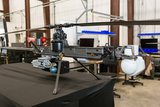Partners claim milestone in merging air threat data from UAVs
MQ-20 Avenger UAV. (Photo: General Atomics)
Two company-owned General Atomics MQ-20 Avenger UASs — each equipped with the Lockheed Martin Legion Pod for infrared search and track (IRST) — have fused passively captured long-range air threat data with an advanced sensor algorithm for transmission to a command centre.
In the test flight, the Legion Pod IRST21 system detected multiple fast-moving aircraft operating in the area. On-pod fusion software from Lockheed Martin blended the sensor data from both pods in real time, and the Avengers streamed it to the ground station.
‘This is the first time IRST systems on multiple autonomous aircraft have delivered merged air threat data to users on the ground,’ said Scott Roberson, director of sensors and global sustainment advanced programmes at Lockheed Martin.
‘It’s a big step in developing a common operating picture that boosts situational awareness across domains in joint operations,’ he added.
The 2h industry-funded flight test was conducted in Southern California on 18 November 2021 but only announced by General Atomics on 10 January 2022. It demonstrated ‘the maturing capabilities of UAS platforms and sensors to deliver fused sensor data’, said Michael Atwood, the company’s senior director of advanced programmes.
He added: ‘Avenger with Legion Pod demonstrates how collaborative autonomous platforms with advanced sensing can deliver persistent, shared air domain awareness.’
Sensor fusion technology with Legion Pods and data links was previously tested on F-15s during Exercise Northern Edge 21.
Related Equipment in Defence Insight
More from Digital Battlespace
-
![Babcock nears first customer for Nomad AI translation tool]()
Babcock nears first customer for Nomad AI translation tool
Nomad can provide militaries with real-time intelligence, saving critical time on the battlefield.
-
![AUSA 2025: Israel’s Asio Technologies to supply hundreds of improved Taurus tactical systems]()
AUSA 2025: Israel’s Asio Technologies to supply hundreds of improved Taurus tactical systems
Taurus operates alongside the Israel Defense Forces’ Orion system which supports mission management across tens of thousands of manoeuvring forces, from squad leaders to battalion commanders.
-
![AUSA 2025: Kopin pushes micro-LED plans as China moves faster]()
AUSA 2025: Kopin pushes micro-LED plans as China moves faster
The plan for the new displays follows fresh investment in Kopin’s European facilities by Theon and an order for head-up displays in fielded aircraft, with funding from the US Department of Defense.
-
![AUSA 2025: Persistent Systems to complete its largest order by year’s end]()
AUSA 2025: Persistent Systems to complete its largest order by year’s end
Persistent Systems received its largest ever single order for its MPU5 devices and other systems earlier this month and has already delivered the 50 units to the US Army’s 4th Infantry Division.
-
![Aselsan brings in dozens of companies and systems under the Steel Dome umbrella]()
Aselsan brings in dozens of companies and systems under the Steel Dome umbrella
Turkey has joined the family of countries attempting to establish a multilayered air defence system with government approval in August 2024 for the effort landed by Aselsan. Dubbed Steel Dome, the programme joins Israel’s Iron Dome, the US Golden Dome, India’s Mission Sudarshan Chakra and South Korea’s low-altitude missile defence system.
-
![DSEI 2025: MARSS unveils new agnostic multidomain C4 system]()
DSEI 2025: MARSS unveils new agnostic multidomain C4 system
MARSS’ NiDAR system has been deployed using sensors from static platforms to provide detection and protection for static sights, such as critical infrastructure, ports and military bases.




























